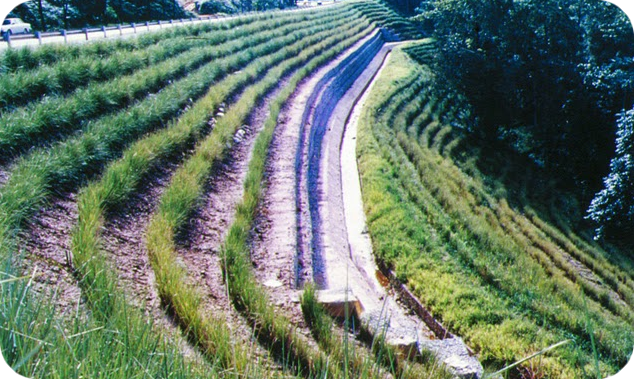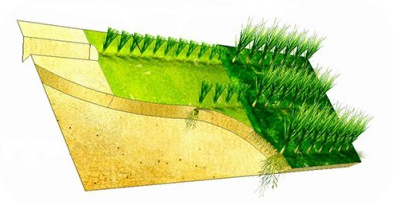Application: Bridges, canals, culverts and drains, drainage, embankments, floodgates, stormwater outfall
Description: Vetiver grass (Chrysopogon zizanioides) is planted as a hedgerow along the contours of sloping land to form a dense vegetative barrier that slows run-off, helps the water soak into the soil rather than washing off the slope, and provides significant soil reinforcement through its roots. With a deep and strong root system, a wide range of pH tolerance, a high tolerance to most heavy metals, an ability to remove nitrates, phosphates and farm chemicals from soil and water, vetiver grass can be an important tool to reduce erosion, improve groundwater recharge, remove pollutants from water, reduce the risk of flooding, and improve economic benefits to communities. Vetiver is native to India, is sterile, non-invasive and has to be propagated by clump subdivision. It is a low-cost, labour-intensive technology.
Contribution to climate resilience: The planting of vetiver grass reduces erosion by protecting the soil from the impact of intense rainfall, slowing down run-off, facilitating water absorption and strengthening the soil with its roots. By these means it increases the resilience of roadside slopes to extreme climatic events. Because it is planted using local labour and locally available materials, it requires less energy, is far more sustainable, and can often be applied in a quicker timeframe than traditional civil engineering works.
Supplementary sources of information:
http://permaculturenews.org/2009/01/19/vetiver-grass-a-hedge-against-erosion/
http://www.vetiversystems.co.nz/
http://www.theherbcottage.com/may-2015-vetiver-grass-of-many-uses/
Background image credit: https://pxhere.com/en/photo/1631422
This resilience-building measure is sourced from the Water Resource Adaptation Guide (2019) published by the National Council for Sustainable Development at the Ministry of Environment in Cambodia. The full Guide is available to download at URL https://ncsd.moe.gov.kh/sites/default/files/2019-10/Water%20Resources%20Adaptation%20Guide_March%202019_En.pdf


